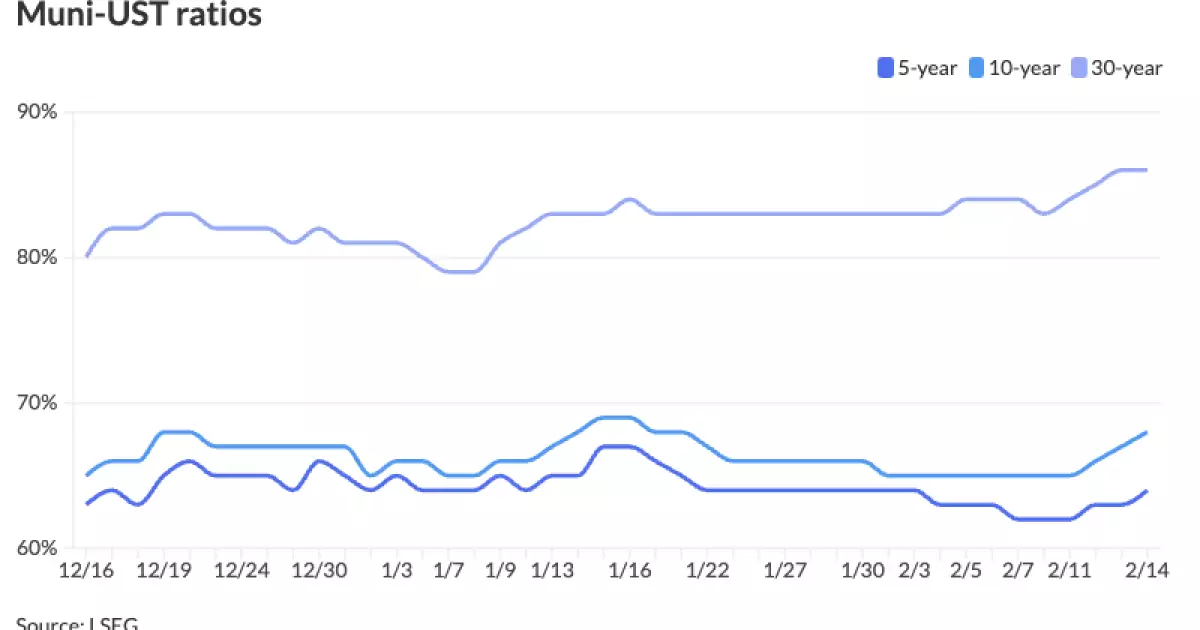The landscape of the municipal bond market is currently shaped by a combination of external factors and internal market dynamics. Recent reports illuminate a period of relative stability within the municipals, even as various pressures—including fluctuations in U.S. Treasury yields and broader economic indicators—have created a complex environment for investors and issuers alike.
In the wake of a tightening labor market and fluctuating economic data, the U.S. Treasury yields have experienced significant shifts. Following the release of a strong January employment report, investors observed a pause in the Treasury market’s upward trajectory. Analysts from Bank of America (BofA) noted this was emblematic of broader trends affecting Treasury curves, particularly as recent consumer price index reports fueled a steeper “bear steepening” in those curves. This implies a growing gap between the yields of short and long-term bonds, indicating market players’ expectations for continued inflationary pressures.
The volatility in rates has inevitably rendered the trading of municipal bonds more complex. Barclays strategist Mikhail Foux indicated that the chaotic nature of Treasury yields has added layers of difficulty for municipal investors, highlighting the necessity for strategic positioning in a market that may remain stagnant for the foreseeable future, pending a clear indication of inflation retreat.
Looking ahead, municipal bond issuance appears to be constricted, with upcoming estimates placing issuance around $5.5 billion—partly due to the holiday-shortened week ahead. While this may suggest a temporary dip in availability, BofA strategists remain optimistic about the overall supply-side dynamics. They anticipate a continuation of healthy supply levels supported by significant redemption volumes and coupon payments that may outpace new issuance.
This week’s data highlighted a notable uptick in cash flow into municipal funds, contributing to a robust supply-demand balance. As issuers prepare for future offerings, recovery in refunding volumes can be observed, thanks to favorable market conditions prior to recent inflation reports.
Further analysis reveals noteworthy shifts in municipal-to-Treasury ratios, which have exhibited slight cheapening. Recent readings established ratios of approximately 63% for two-year munis against U.S. Treasuries, escalating to 68% for 10-year bonds. This reflects the increasing appetite among investors for municipal securities—particularly those that are perceived as undervalued relative to their Treasury counterparts.
Moreover, a significant steepening of the AAA curve has been noted, prompting investors to adopt a more defensive approach toward duration risk in their portfolios. BofA analysts pointed out that, compared to last year’s negative slope, current conditions have depicted a recovery that may signal a paradigm shift in investor sentiment regarding duration exposure.
As the municipal market gears up for the week ahead, many notable deals are poised to enter the competitive and negotiated calendars. Leading the way is Miami-Dade County’s substantial $526 million airport revenue bond issuance, underscoring the latent demand for infrastructure-related financing amidst ongoing economic uncertainties. Other significant offerings include taxable infrastructure-related programs from the Pennsylvania Economic Development Financing Authority and essential school bond measures from Guilford County.
Scrutinizing the upcoming bond offerings reveals a mixture of competitive rates and strategic issuances aimed at fulfilling key infrastructural and educational needs across various jurisdictions. This signals a broader trend within the municipal market towards not just meeting investor demand but also addressing critical community financing needs.
In light of the current market dynamics, municipal investors face a dual challenge: navigating short-term rate volatility while positioning their portfolios for potential opportunities arising from ongoing economic recovery. With an expected climate of range-bound Treasury yields, strategic foresight becomes crucial. Investors should be prepared for sustained uncertainty until inflation metrics demonstrate a clear cooling trend, as highlighted by BofA’s outlook.
Additionally, as we approach the prime issuance season, it would be wise for market participants to remain vigilant about upcoming deals and consider the underlying economic fundamentals supporting these issuances. The interplay of strong demand amidst constrained supply and active fiscal policy measures may set the stage for lucrative opportunities in the municipal bond arena moving forward.
While the municipal bond market currently grapples with various challenges—from Treasury volatility to an evolving economic landscape—opportunities remain for strategic investors willing to navigate this complex environment judiciously.


Leave a Reply